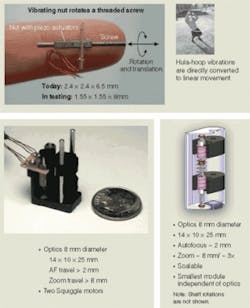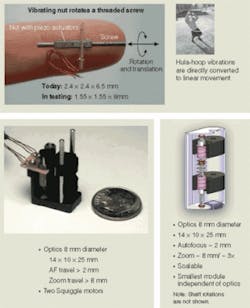Tiny motors squiggle into camera designs
Andrew Wilson, Editor, [email protected]
Digital cameras use electromagnetic rotary stepping or dc motors for autofocus and optical zoom-lens motion. Electromagnetic motors contain many parts, including iron cores, copper windings, and permanent magnets. And while miniature stepper and dc motors can be produced at small size and low cost, they may have reached their limits in terms of miniaturization. Such electromagnetic motors also become less efficient at smaller sizes because more electrical drive power is converted to heat rather than to mechanical motion.
When such designs are used in cameras, power consumption is increased. Smaller motors must also operate at higher speeds to produce significant mechanical power. Therefore, even greater gear-ratio reduction is needed, which increases system complexity, adds parts, further reduces efficiency, and degrades precision.
To overcome these limitations, New Scale Technologies (NST; Victor, NY, USA; www.newscaletech.com) has demonstrated an optical-zoom camera module that may revolutionize how optical zoom and autofocus are implemented in digital cameras. Employing its Squiggle motor technology, the company’s first prototype uses a 2.4 × 2.4 × 6.5-mm linear motor to move a lens approximately 4 mm with better than 10-μm closed-loop repeatability.
According to David Henderson, president and CEO of New Scale Technologies, the design is a motion subsystem that integrates a smooth linear guide, preload springs, limit stops, and a position sensor. Computer control is demonstrated using a credit-card-sized OEM motor controller. “Single-chip controllers are under development by ASIC vendors and will be available in Q2 2006,” he says.
“As cameras designers move to image sensors with greater than 5 Mpixels, both autofocus and optical zoom will be required to take full advantage of those sensors,” says Henderson. “Currently, autofocus mechanisms are driven by short-stroke (less than 0.5 mm) piezoelectric actuators, voice coils, or stepper motors. With higher-resolution sensors, autofocus and optical zoom are difficult to achieve without increasing camera size. A combined autofocus/optical zoom module requires at least two sets of moving optics with greater than 4 mm of stroke (zoom) and coordinated movement with better than 10-μm repeatability.”
Using ultrasonic vibrations to produce linear movement without gears or other additional parts, the design of the Squiggle motor uses a threaded nut with mating screw (see figure on p. 25). This nut is vibrated by piezoelectric ceramic actuators. In operation, the nut vibrates in a “hula hoop” motion at the mechanical resonant frequency.
“Although at resonance the vibration amplitude is only a few micrometers,” says Henderson, “each cycle adds together to produce continuous bidirectional screw movement.”
Two-phase drive signals power the piezoelectric actuators at frequencies up to 150 kHz. While the drive frequency is fixed to the motor’s resonant frequency, drive amplitude controls speed, and phase determines direction. While the Squiggle motor design provides micrometer resolution, a position sensor is required to produce repeatable stepper motion. “Several position sensor options are available to measure the screw rotation or the linear movement,” says Henderson. “These include inductive, Hall Effect, and optointerrupters.”
To achieve autofocus or optical-zoom movements, the Squiggle motor must be integrated with a translation mechanism as it is in NST’s prototype. The end of the Squiggle screw is used to move the lens mechanism, precisely controlling the lens speed and position. Because the screw holds position when power is turned off, camera optics remain in a zoomed and focused position without requiring continuous power.
Currently the piezoelectric motors are being manufactured with diameters of less than 4 mm. In addition, claims Henderson, the Squiggle motor offers ten times better precision and five times greater power efficiency than electromagnetic motors.
“The design uses 90% fewer parts than existing motor designs, can be produced in volume at less than $1/motor, and is very quiet,” he says.

